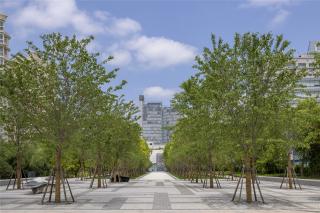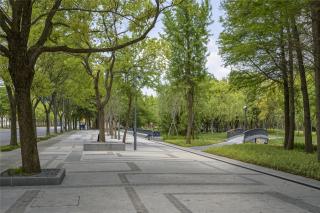上海张江艺术公园景观设计 | WEST 8
-
项目名称:张江艺术公园
-
项目地点:上海浦东
-
项目规模:8.5ha
-
设计公司:
-
委托方:上海张江高科技园区开发股份有限公司
-
建成时间:2019
张江艺术公园位于上海浦东张江科学城西北片区的核心,原来是两座比邻的公园,被春晓路一南一北分开,建于不同年代、风格各异。北侧的公园较为开敞,南侧则林木茂密。张江当代艺术馆位于南侧公园中, 多年以来积攒了大量优秀的室外雕塑作品,密集放置在南侧公园有限的空间中。
作为West 8参与的张江科学城西北片区城市更新项目的一部分,张江艺术公园的整合提升将成为西北片区更新的第一步。在规划上作为西北片区核心带状公共空间--“绿框”公园--的西部起点,张江艺术公园将推动整个西北片区各街区的多样化进程,带动社区商业和文化的发展。
Zhangjiang Art Park is located in the core of the northwest area of Zhangjiang Science City in Pudong, Shanghai. Originally two, adjacent parks divided by the Chunxiao Road in the middle, the north and south parks which were built in different eras and with different landscape styles. The park on the north side was designed with an open character, while park on the south side was densely forested. In addition, the Zhangjiang Contemporary Art Museum is located in the southern park. Over the years, this southern park accumulated a large number of free-standing outdoor sculpture works, which were densely placed in the limited space around the museum.
As part of the West 8’s Northwest District Urban Upgrade Project of the Zhangjiang Science City, the integration and upgrading of Zhangjiang Art Park will be the first step in the renewal of the northwest area. In terms of urban planning, as the western starting point of the central located strip-shaped public space in the northwest area - the "Green frame" park - Zhangjiang Art Park will promote the diversification of the entire northwest area and the development of community commerce and culture.
▼西北片区城市更新总图
Urban Upgrade Master Plan of Northwest District

West 8主导了张江艺术公园的总体规划和景观设计,同时与同济景观院等本地顾问团队进行了深化合作。
景观改造的基础是透彻的城市设计分析以及定位。张江艺术公园改造的第一步,即是明确公园和城市界面,也就是公园与西侧碧波路、南侧祖冲之路两条核心干道的关系。过去,公园和碧波路之间有安全围栏和灌木隔离,内向型的公园既无法通过城市道路积攒人气,也无法为城市街区提供怡人的景观体验。
West 8 led the overall planning and landscape design of Zhangjiang Art Park and cooperated with local consultant teams including the landscape department of the Tongji Architectual Design (Group) Co., Ltd. for the developed design and construction supervision.
The foundation of landscape transformation of the two parks arrived from a comprehensive analysis and positioning from an urban design perspective. The first step was to define the interface between the park and the city, the relationship between the park and the two main roads: Bibo Road on the West and Zuchong Road on the south. In the past, due to the fences and shrubs between the park and Bibo Road, this introverted park could neither accumulate visitors through the urban streets, nor provide a pleasant landscape experience for the surrounded urban blocks.
▼以前的公园边界
former park edge

在“绿框”串联功能的前提指引下,一条全新的滨水道沿着公园碧波路一侧纵向推进。宽阔的滨水道上,三色嵌套重叠的铺装图案,强调了这里作为城市生活魅力核心展示空间的重要性。 同时,它也是内侧柔性公园的景观背脊线,清澈的湖面和茂盛的花木沿着这条主要动线的东侧徐徐展开,发散出去的园路和跨越水面的景观桥使行走在林荫道上的城市人群拥有了随时可以进入或离开公园的灵活选择自由度。滨水道如同一条拉链,将以往割裂的公园和城市街区缝合在一起。景观与城市发展相互带动、共生共荣。
Under the urban reconnecting principle of the green framed park, a brand new waterfront boulevard is extended along the park edge of Bibo Road. On the widened pedestrian walkway, the three-color overlapped paving pattern emphasizes the importance of this location as the core “show- off space” as the charm of urban life. At the same time, it also acts as the landscape ridgeline between the soft and green park on the inner side. The clear lake and lush flowers and trees slowly spread out along the east side of this main traffic axis. The diverging park paths and the pedestrian bridges across the water give the urban crowd on the boulevard the flexibility to enter or leave the park at any time. The waterfront boulevard is like a zipper, stitching the previously separated parks and urban blocks together. This project is proof that integrating Landscape and urban development drive, coexist and prosper each other, together.
▼滨水道和园路系统
waterfront boulevard and path system

▼滨水道
waterfront boulevard

▼滨水道铺装图案
paving pattern of the waterfront boulevard

公园南侧,交通繁忙的祖冲之路和地铁2号线张江高科站正对着张江当代艺术馆的中轴线。一座樱花树冠覆盖的入口广场直接面对车流湍急的祖冲之路,宣示着公园的主入口和通往艺术馆的轴线。繁茂的树冠,过滤掉祖冲之路上的喧嚣氛围,将人们一步步带入公园的绿色环境。中轴线的改造尊重原有的格局,保留了经年生长成型的大乔木,同时理清林下空间、统一设计语汇,将这一区域多年来逐渐散乱的空间整理为清晰的“轴线-林下步道-水岸”三层并列动线。
On the south side of the park, the Zuchongzi Road with its heavy traffic and Zhangjiang High-tech Metro Station are facing the axis of Zhang Contemporary Art Museum. The entrance plaza, covered by the cherry tree canopy, faces the turbulent traffic to declare the main entrance of the park and strengthen the axis towards the Art Museum. The lush canopy filters out the noise of the Zuchongzi Road and brings people into the green environment of the park step by step. The transformation of the museum axis respects the original layout. The large trees that have grown over the years are kept. At the same time, the space under the trees are cleaned and unified with a coherent design language. The space in this area, which has been gradually scattered over the years, is now reorganized into a clear and linear space, a three-layer axis of "museum - green trail - waterfront walkway".
▼以前的艺术馆轴线
former museum axis

▼树荫下的入口广场和艺术馆轴线
the entrance plaza under the tree canopy and the museum axis

公园的园路在原有路网结构上做了整理和调整。可以重复利用的现状路基被尽可能再利用;对公园未来整体流动性有阻碍的园路,则果断拆除。硬质景观的选材均使用舒适低调的灰色。主园路的路面材料使用适合市民慢跑的灰色沥青,次园路则是传统稳重的青灰色陶土砖拼嵌路面。
园路两侧以宽于一般公园园路的30公分花岗岩侧石配合小弹石夹道。视觉上精致、稳定,也更易于两侧的绿化衔接及养护。侧石的截面是一道平缓的下落弧线,与路面的排水弧度对接,形成园路如同厚垫子一般的“弹性”视觉效果。“硬景软做”--温和柔软的亲近感,为锋利硬朗的硬质砖石景观带来预想不到的观感体验。
The original paths in the park have been reorganized and adjusted. The existing foundation that can be reused is recycled as much as possible; whereas the park paths which hinder the overall accessibility of the future park is decisively removed. The selection of hard landscape materials are a comfortable and low-key gray color: The main pathways uses gray asphalt which is suitable for jogging, the secondary pathways use traditional and stable blue-gray bricks.
30 cm wide granite curbstones, wider than the general park path, and small cobble stones are holding the path in place on both sides. Besides visually delicate and stable, it is easier to transfer to and easier to maintain the soft green on both sides. As the extension of the drainage slope of the path surface, the cross-section of the curbstone is a gentle curve, akin to a pillow, as a cushioned edge to the soft terrain. "The soft hardscape" - the gentle and soft look and feel bring an unexpected closeness to the sharp and hard granite and brick landscape.
▼硬景”软”做
the “soft” hardscape

曾经密集放置在南侧公园内的雕塑艺术品是这座公园隐藏的财富。但是仅南侧公园的规模已无法提供足够空间来充分展示这些艺术品的价值。在这次改造中,雕塑品沿南北两部分公园的园路,根据主题被重新编排布置。在全新设计的地形、水景和植被群落衬托下,这些艺术品拥有了各自独立的舞台,成为公园最有代表性的景观和视线的焦点。
The artworks, previously densely placed in the park on the south side, are now the hidden treasures of the combined park. During this renovation, the artworks were rearranged, repositioned and relocated in both north and south parks of the park. Against the backdrop of the newly designed terrain, water features and vegetation communities, these artworks with their own independent stages turn to be the most representative focus points in the park an provide a unified theming to the combined parks.
▼在以前的公园中,艺术品密集放置
artworks densely located in the former park

▼艺术品成为公园最有代表性的景观和视线的焦点
artworks turned to be the focus points in the park

▼艺术品拥有了各自独立的舞台
artworks obtained own stages

公园原有的湖面和水道,既是游览空间划分的主要元素,也是艺术品展示的重要舞台。公园的改造需要从水体改造开始。因淤积而断开的几片水系被重新打通。淤泥经过清理后,水底种上了可以改善水质的生态水生植物。原本浑浊的水体再次成为市民亲水戏水的好去处。水边坡岸上,种植有大片自然葱郁的水生花卉和植物,雕塑品伏于水畔,自然与艺术随季节变化而精彩纷呈。
The original lake and waterways in the park are not only the main elements dividing the park spaces, but also an important stage for the display of the artworks. The transformation of the park needs to start with the transformation of the water body. Water bodys that had been disconnected due to siltation were relinked. After the silt is cleaned up, ecological water plants that can improve water quality are planted on the bottom of the water. The former muddy water body once again became a leisure place for citizens to congregate. Large surfaces of lush flowers are planted on the sloping banks. Today, you will see sculptures are lying on the waterside, as nature and art are both expertly highlighted with the changing of the seasons.
▼清洁的湖水吸引市民亲水戏水
the clean lake became a leisure place for the citizens

▼水边坡岸上葱郁的水生花卉
flowers on the water edge

这次改造的另一个决定性措施, 是清理公园中丛生的园林类杂灌木。经过多年生长,园中的林灌木茂密。但由于缺乏统一的养护标准,公园中的中下层植被生长过度。加上原有古典园林式的多层植物配置方式,使得公园的可达性、安全性和公共活动属性受到严重干扰。甚至于常来此地的人都不曾意识到这座公园的存在。
Another important measure for this renovation was the cleaning up of the garden-style bushes in the park. After years of growth, due to the lack of coherent maintenance standards, the middle and lower vegetation in the park had become overgrown and dense. People who often visited the area were not aware of the existence of the park. This overgrown, dense planting was a symptom of the former classical garden-style multi-layer planting strategy. Today, the park’s accessibility, safety and public awareness is greatly improved.
▼以前,丛生的园林类灌木遮挡视线
in the former park, overgrown garden-style bushes blocks the view

一座位于城市核心区的市民公园需要与之匹配的植栽策略。 经过多轮方案比较,业主项目管理团队和设计团队下决心做减法,将阻隔视线和游客活动的0.8-2米区间中高类灌木去除,打造可以成为城市开放空间的“疏林草地”景观。打通后的公园视线深远、舒朗大气、绿草浓荫,通过开敞、富有层次感的绿色空间,城市-公园一体化的人群视线监控,消除了以往公园带给人的局促和不安全感。
公园现状的乔木品种非常丰富。多年生长后,移栽的苗木伞盖已经打开,高大舒展,形成了一般新建公园无法比拟的林冠覆盖效果。在制定改造策略时,除了必要的清理移除外,大部分生长良好的乔木都被保留。必须新增乔木的区域,有目的性地控制在榉树(滨水道)和落羽杉(公园内部绿化)这两个品种范围内,在保持原有乔木多样性的同时,避免形成杂乱的视觉效果。
A civic park located in the city center needs a matching planting strategy. After rounds of scheme comparisons, the client’s project management team and the design team together determined to remove the medium-high shrubs. Planting in the range of 0.8-2.0-meter-high which blocked the sight and tourist activities were removed to create a type of landscape that can become an public open space in the city: a sparse forest with grass field. Today, the opened-up park has far-reaching sight-lines, a comfortable atmosphere and casts welcoming green shadows. The open layered green spaces and the city-park feeling help to eliminate the previously cramped, unsecured park.
Comparatively, the current tree species in the park are very rich. After years of growth, the canopies of the transplanted trees have opened and fully stretched to form a covering that is incomparable by newly-built parks. While making the transformation strategy, besides the necessary cleaning and removing, most of the well-growing trees have been retained. The area where new trees must be added is purposefully controlled within the range of the two tree species: zelkova is placed on the boulevard and swamp cypress is planted within the park. This maintains the diversity of the original trees, but avoids a messy or cluttered view.
▼保留下来的高大乔木和全新的主题地被植物带
preserved mature trees and new themed groundcovers

南北区一大一小各有一块阳光草坪,为市民的休闲活动提供了足够的开放空间。林荫之下则是蜿蜒伸展、起伏有致的地被植物带,高度均在一米以下。植物带根据生长环境分为浓荫、常绿、杜鹃谷、四季花境四个缤纷主题,与色彩中性、风格统一、简洁低调的硬质景观形成对比。植物的选择以造型蓬松饱满、易于养护为标准,避免使用质感和外形过于人工化的植物,或是在某些季节或生长阶段外形散乱不可控的品种。行走在园路上,穿行过一片片四季色彩更迭、主题交替变化的植物群落,赏心悦目的同时也再次强调出公园以人为本、以自然为主、以硬景为辅的设计主旨。
Combined, the North and South parks have a large and one small open, sunny lawn, providing space for recreation of leisure activities for visitors. Under the shade of the trees are winding, undulating ground cover belts, all below one meter of height. In accordance to the growing environment, the ground cover belts are divided into four colorful themes: thick shade, evergreen, rhododendron valley and a four seasons herbaceous border, which provide contrasts with the neutral color, uniform style, simple and low-key hard landscape. The selection of plants is not only full and natural, but also easy to maintain. The design team carefully avoided using plants with artificial textures or appearances, or species with uncontrollable growth stages or appearances in certain seasons. Walking on the park paths, passing through the patches of plant communities with seasonal colors and different themes, it is a treat for the eyes and also emphasizes the people-oriented design goal of the park: nature as a priority, hardscape as background.
▼市民尽情享受阳光和清新的空气
Citizens enjoy the sun and fresh air

West 8认为:改造类项目需要挑战更多的实际落地问题。特别是在项目后期,会面临各类现场突发情况,要求业主方和设计方不断根据调整中的时间表、造价、规范、地下开挖情况做出相应的妥协。
一个项目很容易因为各类琐碎而密集的外部压力,偏离原有的整体策略,导致空间的碎片化和设计语汇的紊乱。在这个项目中,业主方与设计方的密切合作尤为关键。设计方必须从专业角度为业主提供客观可靠的陈述和建议,以协助业主保持全局性的视角,做出目光长远的决策。这个过程,既包括城市设计角度的整体把性控,也包括细节调整过程中的统一性坚持。
West 8 believes that, within a transformation project, there is a need to challenge and propose practical implementation methods and understand the issues regarding a renovation. Especially in the later stages of the project, there will be various on-site emergencies, requiring both owner and the designer to make corresponding compromises according to the adjusted timetable, cost, specifications, and underground excavation conditions.
A project can easily deviate from the original total strategy due to various trivial and intensive external pressures, leading to the fragmentation of space and the disorder of design vocabulary. In this project, the close cooperation between the client and the designers is particularly crucial. The designer must provide the client with objective and reliable explanations and provide suggestions from a professional perspective to help the client maintain a holistic perspective to make long-term decisions. This process includes not only the overall control from the urban design perspective, but also the persistence on unities in the process of detail adjustment.
▼视线深远,富有层次感的绿色空间
A layered green space with far-reaching vision

艰苦的工作也带来了丰厚的回报。张江艺术公园场地先天的资源优势--成型的大树和卓越的艺术品,经过设计师的梳理,在开放的第一时间为公园奠定了不可替代的氛围感。且由于它们已经时间的考验,必定会借助于全新的“骨架”,在未来很长一段时间内,持续性地为周边城市和市民输出高品质的开放空间“红利”。
Within this project, hard work brought great rewards. The natural advantages of the site --- large trees with beautiful shapes and excellent artworks laid an irreplaceable atmosphere for the park at the first moment after opening. Because the natural environment already passed the test of time, the new park "framework" provided by West 8 has provided a high-quality open space which will benefit the surrounding city and neighbourhood for a long time in the future.
项目名称:张江艺术公园
项目位置:上海浦东张江科学城
设计时间:2017-2018
建成时间:2019年
项目面积:8.5公顷
委托方:上海张江高科技园区开发股份有限公司
合作机构:同济大学建筑设计研究院(集团)有限公司
Project: Zhangjiang Northwest Area – Art Park
Location: Shanghai, China
Design: 2017-2018
Realisation: 2019-2019
Size: 8.5ha
Scope of Works: park renovation
Client: Zhangjiang Hi-Tech Park Development Company
Design Team: Christian Dobrick, Yichun He, Laura Font Gallart, Yuxin He, Emanuele Paladin, Fernando Diez, XiaoJun Liu, Francesca Pelizzaro, Ela Chojecka
In association with: Tongji Architectual Design (Group) Co., Ltd.
More information: pr@west8.com
版权声明:本文版权归原作者所有,请勿以景观中国编辑版本转载。如有侵犯您的权益请及时联系,我们将第一时间删除。
投稿邮箱:info@landscape.cn
项目咨询:18510568018(微信同号)


























